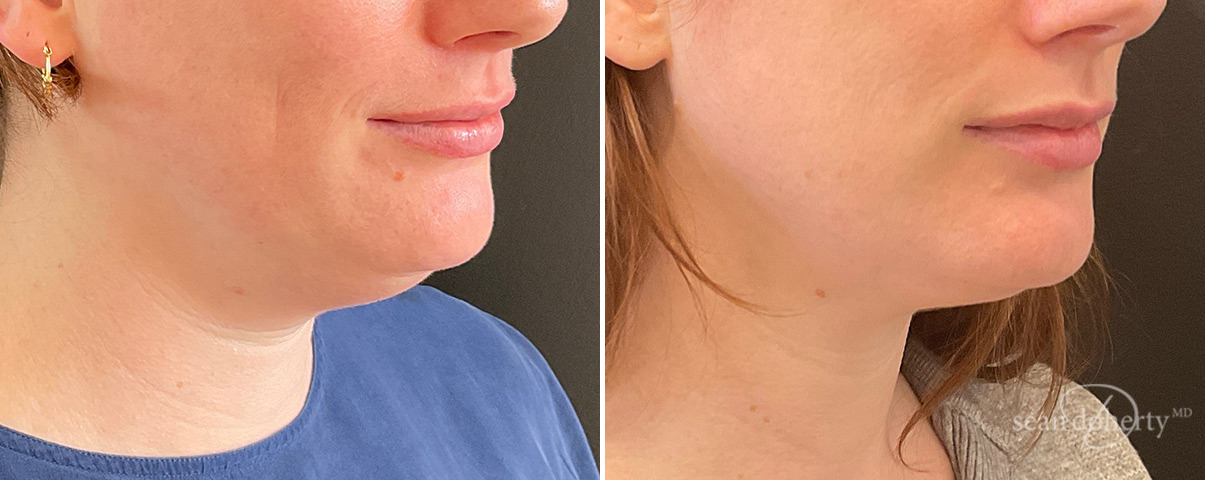Your face is like a calling card. It’s one of the primary things that people notice about you. Furthermore, facial expression, along with language, is how we all communicate. Your face also tends to be the first thing that you see every morning in the bathroom mirror while brushing your teeth or shaving. So, when your reflection no longer matches how you feel on the inside, it can have a seriously adverse effect on your self-esteem. The early signs of aging may be some fine lines around the eyes when you smile, mild grooves between your eyebrows or an overall sag. As Father Time marches on, you may notice the effects of lifestyle choices such as sitting in the sun, avoiding sunscreen or smoking. These can all result in sunspots, redness and a general uneven, crepey texture to the skin. Eventually, the tissues of the face will begin to droop and sag, causing jowling in the lower face and wrinkles in the neck. This is due to gravity and it is inevitable — for everyone. It’s also typically the point at which facial rejuvenation jumps from non-surgical modalities such as fillers and Botox® to surgical modalities like a Neck Liposuction.

Board Certified Plastic Surgeon Dr. Sean Doherty offers his Boston area patients the full range of surgical procedures for addressing facial aging. For him, the key to a successful outcome is not just matching the right procedure to your individual anatomy and needs, but it’s also about his willingness to be completely straight up and honest about what a procedure can and cannot deliver. Dr. Doherty prides himself on his ability to manage patient expectations while also delivering superior care and exemplary surgical results.
Facial Surgery Consultation
The first step for anyone who is considering an aesthetic procedure for facial aging is to schedule an in-person consultation with Dr. Doherty at one of his Boston area locations. During your consultation, he will listen closely to what is bothering you about your face. Thanks to the internet, patients today are more educated and aware of plastic surgery procedures than ever before. However, this oftentimes results in a patient who will come in requesting a specific procedure yet complain about a totally different issue. It is Dr. Doherty’s job to listen in order to understand what is really bothering you about your face. Next, he will ask about any previous facial surgeries, procedures and your current skin care regime as well as perform a thorough physical exam. The goal is to unearth the root cause of your facial aging issues by assessing your:
- Skin tone & texture
- Muscle laxity
- Degree of excess tissue
Together, you will then discuss the best procedure or procedures for delivering your ideal outcome. Your facial rejuvenation plan may include one or more of the following:
- Dermal Fillers
- Laser Rejuvenation
- Thread Lift
- Neck Liposuction
Thread Lift
A thread lift is an old procedure from the ’90’s that has recently been updated with exciting, safe and predictable results. Dr. Doherty offers his Boston area patients two options when it comes to the thread lift: PDO Threads and Silhouette Instalift. Both procedures work in the same manner. Biodegradable, polymer “barbed” or “coned” threads are placed beneath the surface of your skin through a couple of very small incisions. The underlying tissues catch on the barb or cone which lifts them into a higher, more youthful looking position. Over time, the threads dissolve, but the collagen that your body produces in response to the “injury” of the thread remains. Since collagen is somewhat like the fountain of youth, the result is a rejuvenated looking you.
The important thing to keep in mind with a thread lift is that it is a great option for the right patient. This is someone with good skin elasticity and just a mild degree of sagging or looseness in the lower face and jowl area. The results from a thread lift are not permanent and are not going to be as dramatic as those from a neck liposuction, but in the right patient or for someone who does not want surgery, this can be a great option. A Thread is excellent for a subtle improvement.
*Each patient is unique and individual results may vary
Neck Liposuction
Excess fat in the neck can make you feel self-conscious. It can also be incredibly aging. This is true for both men and women although men who wear ties are particularly bothered by fat that hangs over their collars. Neck liposuction is a quick, effective method for cleaning up the jaw/neck juncture. It can be performed in the office under local anesthesia. This makes it ideal for patients who are “on the go” as it greatly reduces your recovery time. The ideal patient for neck liposuction, however, is going to be someone who has good skin tone and elasticity so that your skin can “bounce back” once the extra fat is removed. Although there are non-surgical options for treating this area such as SculpSure, Coolsculpting and Kybella®, neck liposuction gives Dr. Doherty the ability to truly sculpt your neck into a slimmer, lifted and more vital looking position. Dr. Doherty will often combine liposuction with Radiofrequency to encourage skin tightening, with Threads to create a lift and will for chin and jawline enhancement.
*Each patient is unique and individual results may vary
To find out more about plastic surgery for the face with Dr. Sean Doherty at his Boston or Brookline office, contact us today or call (617) 450.0070 to schedule a consultation.
FAQ’s about Facial Surgery
You don’t. That’s my job. When you come in for your facial aging consultation, I will examine the degree of looseness in the skin and tissues of your face and make a recommendation. But the right choice for you is also going to depend on your lifestyle and ability to tolerate downtime. I will always be honest with you about what I think is the best procedure for achieving your goals, but if you don’t want to deal with the recovery of a facelift, we can certainly discuss what you can expect to achieve with a thread lift. The important thing is that you know your options and have realistic expectations about what each can deliver for you. This way, you can make a truly informed decision.
It depends. Dark circles can result from a number of issues. Some patients simply have a genetic predisposition. While for others, the dark circles are the result of the lower fat pad migrating towards the outer corner of the eye. A dark circle is really just a shadow and the coloration of a muscle behind thin eyelid skin. While filler may help, it is NOT, as the internet may lead you to believe, “the end all, be all” for everyone. I would advise you to first schedule a consultation with a board certified plastic surgeon who is adept with both surgical and non-surgical modalities for treating aging eyes. Only a comprehensive, in person exam can determine the right procedure or procedures for you. Filler under the eyes can be beneficial, but it can also be truly disastrous in the wrong hands.
Figuring out the cost of a non-surgical facelift is always going to require an in-person consultation. There are any number of procedures that fall under the moniker “non-surgical facelift” including injectables such as filler and Botox®, fat reduction therapies like SculpSure® and skin tightening modalities such as FlexSure® or Renuvion®. I take cost seriously. Sometimes, a non-surgical facelift can actually wind up being more expensive than a surgical facelift. This is why I always spend time during your consultation discussing what bothers you the most about your face, and breaking down what a procedure will deliver over time.
One of the things that I love about plastic surgery is that there are always options. If you don’t have a large degree of loose skin then you may be an ideal candidate for Kybella® which is an injectable that melts submental fat under the chin. Liposuction is also an option. Neck liposuction can be safely and effectively done under local anesthesia. These are great alone, but I will often also combine either with a skin tightening procedure like Thermi RF or Profound. However, again, these non-surgical modalities really only deliver ideal results in patients with just a mild degree of loose skin. So, make sure to be assessed in person by a board certified plastic surgeon. It is worth the consultation fee. I promise.
Yes and no. To me, a good neck lift always addresses the lower part of the face. They work in sync. Furthermore, the neck lift incisions are the same as those for a lower face lift. In order to achieve that crisp, defined jaw, the skin and tissues of the neck must be lifted up along the lower face. But in patients who don’t have any heaviness to the brow, the upper half of the face will be left alone. This greatly reduces the extent of your incisions.



